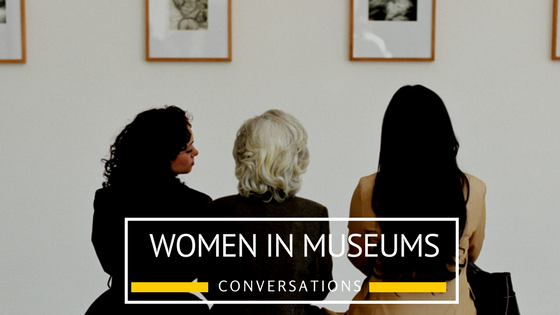
by Hillary Ryan, Communications and Programs Strategist, Western Museums Association
No matter what point you are in your career, figuring out how to navigate the ins and outs of your job, as well as preparing yourself for the next growth opportunity can be greatly assisted through mentorship. Research shows that women and people from traditionally underrepresented groups do better than the general population – in terms of engagement, retention and promotions – when they have mentors. A mentorship can help you unlock your talents, connect you with people that support your growth and push you to make the leaps that may seem out of reach right now.
To develop current and future leaders in the museum profession, women are often encouraged to 'find a mentor'. While that is easily said, how does one locate someone to be a mentor? And further, what can you do to mentor others?
BEING A MENTOR
No matter what stage of your career you are in, you can be a mentor. EMPs (now defined by AAM as 0-10 years experience) have a plethora of experiences that can help others looking to know more about the field or within your specific specialty. Mid-level professionals have plenty to offer, as do those in the C-suite and executive levels, as they chart the course for their organizations and consider succession planning.
While not museum focused, a great example of mentoring at all levels can be found from Girl Scouts of America. Not only are girls encouraged to be leaders and mentors to other girls, but adult leaders are given similar opportunities to grow their skills in scouting activities as well as group leadership and helping girls navigate tough conversations and situations.
In preparing to be a mentor, think about the following:
1. Begin with your own experiences
• Think about what you wish you had known when you were starting off in your career.
• Share your career path.
• Reflect on the people who mentored you and what you gained from that experience.
2. Share what you know now
• Share your failures and triumphs.
• Model leadership skills.
• Provide insight and wisdom.
• Share work ethics and values.
3. Provide perspective
• Help your mentee to recognize both her strengths and opportunities for growth.
• Be candid with your feedback; your perspective could be one that your mentee has never experienced.
4. Enjoy the benefits of being a mentor
• Take advantage of the two-way exchange of advice and new perspective.
• Gain a sense of fulfillment for passing your wisdom on to others.
5. Know the limits to mentoring
• Don’t feel you have to know all the answers.
• Expect some failure, but don’t let this get in the way. Keep trying and things should get on the right track.
• Not every mentor/mentee relationship is going to be a success but that does not mean the next one won’t work out.
(Source: Penn State’s Women’s Leadership Initiative)
LOOKING FOR A MENTOR
In seeking a mentor, the first step is establishing your own network. A professional network is a great way to meet and develop meaningful relationships with people and receive opportunities to leverage your skills, collaborate with talented teams, and learn new skills. It can be challenging to make networking feel natural but it’s possible to weave it into your professional work. WMA’s Annual Meeting is a great place to start. Before the conference, research the speakers and presenters that you are interested in meeting and determine how best to approach conversations. When you meet someone new, ask them questions about themselves, where they work, what they do. Many people enjoy sharing about themselves and knowing more about someone can help you better relate to them.
Once you’ve found someone that you think would be a good mentor, it’s up to you to start the conversation about a mentorship. A mentor/mentee relationship can enhance your skills, business acumen, and provide you with valuable insight, guidance, and feedback as you seek to move forward in your career. A mentor is someone who you know and admire, whose experience and perspective can help guide you in your personal and professional growth. A common misperception is that your mentor has to be someone like you, has the job you want, or is in your organization. However, leadership competencies are universal. Pairing yourself with someone in a different nonprofit, sector, or field could give you a broader view of your organization, new ways to approach challenges within your work, and different perspectives on how your skills can contribute to the overall success of your mission.
ELEMENTS OF A SUCCESSFUL MENTORSHIP
Make your mentorship count by continuously evaluating its progress.
Every good mentorship should:
Have a goal in mind. - Define a goal you’d like to achieve that can serve as a guide for your mentorship.
Be a conversation. - A mentorship should be a two-way street, with both mentor and mentee exchanging ideas, thoughts, and advice. Your mentor can learn from you, too!
Meet regularly. - Unless you and your mentor can commit to consistent meetings, your progress will be paused and diverted, diluting the impact of your mentorship.
Challenge you. - A good mentor will provide you with inspiration (blogs, books, etc.), projects, and exercises that will push you to progress. Ask yourself, what’s new to you after this is over?
Make valuable connections.-Your mentors should make introductions for you that can help you grow your network, obtain new skills and opportunities, and move forward in your career.
Mentorships can, just as Katy Perry sings in “Fireworks”, be the lightening bolt that helps you grow.
RESOURCES:
5 things you need to know about successful networking from GEMM
Be Leaderly- Mentorship and Leadership for Women
From Forbes- Mentoring Matters: How More Women Can Get The Right People In Their Corner








Add new comment